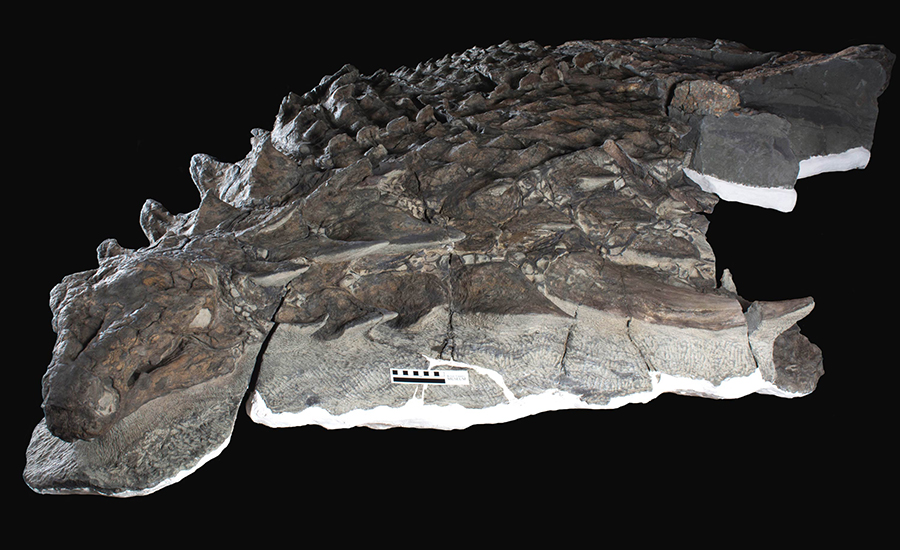Borealopelta's Last Meal: A 110-MYO Dinosaur's Stomach Contents Are Revealed

Paleontologists in Canada have analyzed the fossilized stomach contents from the exceptionally preserved specimen of Borealopelta markmitchelli, a species of nodosaur (a type of ankylosaur) that lived about 110 million years ago during the Cretaceous period.
Borealopelta markmitchelli’s spectacularly detailed ‘mummified’ remains were found by accident in March 2011 by excavator operator Shawn Funk at the Suncor Millennium Mine in Alberta, Canada.
The specimen was exceptional in preserving soft tissue, including scales and keratinous coverings of the bony armor across the body, while also maintaining its 3D shape.
In addition to the animal tissue, a large spheroid mass within the dinosaur’s abdominal cavity was also preserved.
“The finding of the actual preserved stomach contents from a dinosaur is extraordinarily rare, and this stomach recovered from the ‘mummified’ nodosaur by the museum team is by far the best-preserved dinosaur stomach ever found to date,” said senior author Dr. Jim Basinger, a geologist in the Department of Geological Sciences at the University of Saskatchewan.
“When people see this stunning fossil and are told that we know what its last meal was because its stomach was so well preserved inside the skeleton, it will almost bring the beast back to life for them, providing a glimpse of how the animal actually carried out its daily activities, where it lived, and what its preferred food was.”

Dr. Basinger and colleagues found that the diet of Borealopelta markmitchelli consisted of 88% leaf material, but also included stems, wood and charcoal.
The leaf fraction was dominated (85%) by leptosporangiate ferns, the largest group of ferns today.
“The last meal of our dinosaur was mostly fern leaves — 88% chewed leaf material and 7% stems and twigs,” said co-author Dr. Cathy Greenwood, a researcher in the Department of Biology at Brandon University.
“When we examined thin sections of the stomach contents under a microscope, we were shocked to see beautifully preserved and concentrated plant material.”
“In marine rocks we almost never see such superb preservation of leaves, including the microscopic, spore-producing sporangia of ferns.”
Specifically, they identified 48 palynomorphs (microfossils like pollen and spores) including moss or liverwort, 26 clubmosses and ferns, 13 gymnosperms (mostly conifers), and two angiosperms (flowering plants).

“Also, there is considerable charcoal in the stomach from burnt plant fragments, indicating that the animal was browsing in a recently burned area and was taking advantage of a recent fire and the flush of ferns that frequently emerges on a burned landscape,” Dr. Greenwood said.
“This adaptation to a fire ecology is new information. Like large herbivores alive today such as moose and deer, and elephants in Africa, these nodosaurs by their feeding would have shaped the vegetation on the landscape, possibly maintaining more open areas by their grazing.”
The team also found gastroliths, or gizzard stones, generally swallowed by animals such as herbivorous dinosaurs and today’s birds such as geese to aid digestion.
“Taken together, these findings enable us to make inferences about the ecology of the animal, including how selective it was in choosing which plants to eat and how it may have exploited forest fire regrowth,” said lead author Dr. Caleb Brown, a paleontologist at the Royal Tyrrell Museum of Palaeontology.
“It will also assist in understanding of dinosaur digestion and physiology.”
The study was published in the journal Royal Society Open Science.
_____
Caleb M. Brown et al. Dietary palaeoecology of an Early Cretaceous armoured dinosaur (Ornithischia; Nodosauridae) based on floral analysis of stomach contents. R. Soc. open sci 7 (6): 200305; doi: 10.1098/rsos.200305
Source: www.sci-news.com/








